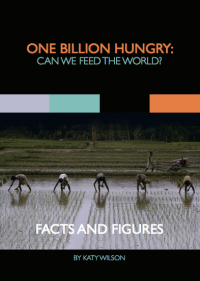 Malnutrition, in its various forms, is thought to affect over 2 billion people in the world and, as such, has far reaching consequences for societies, economies and livelihoods. Tackling poor nutrition is both complex and opportunistic in that there are links between nutrition and a whole other range of factors. In other words by tackling nutrition directly we may positively contribute to other developmental problems but there are also multiple ways to address undernutrition indirectly. While there is broad consensus on the need to take direct nutrition interventions such as promoting exclusive breastfeeding or biofortification of crops with micronutrients such as vitamin A or zinc, there is also an urgent need to tackle the underlying and inter-related determinants of malnutrition. The Lancet, for example, suggests that direct nutrition interventions, even if implemented at 90% coverage in high-burden countries would only reduce global stunting by 20%.
Malnutrition, in its various forms, is thought to affect over 2 billion people in the world and, as such, has far reaching consequences for societies, economies and livelihoods. Tackling poor nutrition is both complex and opportunistic in that there are links between nutrition and a whole other range of factors. In other words by tackling nutrition directly we may positively contribute to other developmental problems but there are also multiple ways to address undernutrition indirectly. While there is broad consensus on the need to take direct nutrition interventions such as promoting exclusive breastfeeding or biofortification of crops with micronutrients such as vitamin A or zinc, there is also an urgent need to tackle the underlying and inter-related determinants of malnutrition. The Lancet, for example, suggests that direct nutrition interventions, even if implemented at 90% coverage in high-burden countries would only reduce global stunting by 20%.
So-called nutrition-sensitive approaches are gaining popularity and the importance of including nutrition in a wide variety of sectors and policies is becoming better understood. Here we discuss some of the alternative routes through which malnutrition is impacted and thus could be reduced.
- Agriculture
The contribution of agriculture to meeting the nutritional needs of the population cannot be overstated, and the nutrition component of agricultural policies and investment plans needs to be strengthened. In Africa, agricultural development has been primarily focused on boosting production and developing markets with little attention given to nutrition. But agriculture is at the heart of addressing malnutrition. Its products provide us with the energy, protein, vitamins and minerals our bodies need. And in many developing countries the majority of people who are malnourished live in rural areas and depend on smallholder farming for their livelihoods. In fact, demographic and health survey (DHS) data shows that individuals living in rural areas are between 1.3 and 3.3 times more likely to be stunted than people in urban areas, which indicates that agriculture still has a long way to go in providing the global population with the right nutrition and adequate calories. It also indicates that by improving agricultural diversity and productivity in rural farming areas, malnutrition could be significantly reduced, although evidence on the impact agriculture can have on nutrition is currently limited in formal literature.
So how does agriculture need to change in order to better serve the world’s nutritional needs? The food system needs to provide access to enough nutritious foods, promote social norms that foster good nutrition practices and provide adequate income to purchase nutritious foods. Ensuring nutritious foods are affordable, accessible and available is essential and has typically been overlooked in the agricultural sector, rather being the domain of development and health. Home and school gardens, small livestock production, aquaculture and marketing policies which keep the prices of such foods at affordable levels are examples of food-based nutrition improvement initiatives. Some argue that the entire food chain needs to be put under a “nutrition lens” in order to identify areas for intervention such as “expanding and diversifying food production, improving food processing, preservation and preparation of foods, reducing losses and waste and assessing intervention impact on dietary consumption”.
The Soils, Food and Health and Communities (SFHC) project, used participatory research methods and awareness raising activities in Ekwendeni village in Northern Malawi to help smallholder famers select and test mixtures of diverse legume species for growing in combination with maize. Project results show that the intercropping of maize with legume mixes has led to improved nutrition for children in communities where the project is being implemented (over 9000 farmers have adopted this technology so far). [Read more…]









